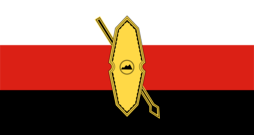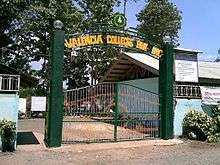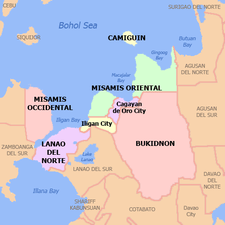Bukidnon
| Bukidnon | |||
|---|---|---|---|
| Province | |||
| Province of Bukidnon | |||
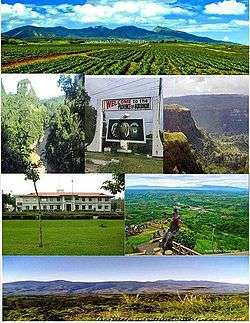 Top to bottom: Kitanglad Range National Park; Pulangi River at San Jose, Quezon; Bukidnon Welcome Marker at Alae, Manolo Fortich; Mangima Canyon; Bukidnon Provincial Capitol; Overview at Palacapao, Quezon; Kalatungan Range National Park | |||
| |||
|
Nickname(s): "The Primary Food Basket of Mindanao" "The Eco-tourism and Cultural Heritage Capital of Northern Mindanao" "Highland Paradise in the Heart of Mindanao" [1] | |||
| Anthem: Bukidnon Kanak Ha Banuwa | |||
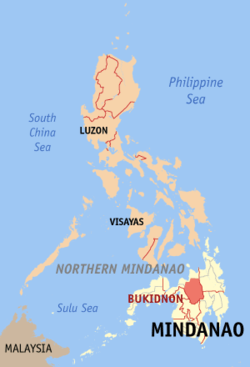 Location in the Philippines | |||
| Coordinates: 7°55′N 125°05′E / 7.92°N 125.08°ECoordinates: 7°55′N 125°05′E / 7.92°N 125.08°E | |||
| Country | Philippines | ||
| Region | Northern Mindanao (Region X) | ||
| Founded | September 1, 1914 (Commission Act 2408)[2] | ||
| Capital | Malaybalay | ||
| Government | |||
| • Type | Sangguniang Panlalawigan | ||
| • Governor | Jose Maria R. Zubiri, Jr. (Bukidnon Paglaum Party) | ||
| • Vice Governor | Rogelio N. Quiño (Bukidnon Paglaum Party) | ||
| • Provincial Board |
Members
| ||
| Area[3] | |||
| • Total | 10,498.59 km2 (4,053.53 sq mi) | ||
| Area rank | 3rd out of 81 | ||
| Highest elevation (Mount Dulang-dulang) | 2,941 m (9,649 ft) | ||
| Population (2015 census)[4] | |||
| • Total | 1,415,226 | ||
| • Rank | 16th out of 81 | ||
| • Density | 130/km2 (350/sq mi) | ||
| • Density rank | 61st out of 81 | ||
| Divisions | |||
| • Independent cities | 0 | ||
| • Component cities | |||
| • Municipalities | |||
| • Barangays | 464 | ||
| • Districts | 1st to 4th districts of Bukidnon | ||
| Time zone | UTC+8 (PST) | ||
| ZIP code | 8700–8723 | ||
| IDD : area code | +63 (0)88 | ||
| ISO 3166 code | PH | ||
| Spoken languages | |||
| Income Classification | 1st class[3] | ||
| Website |
www | ||
Bukidnon (/buːˈkɪdnɒn/; officially the Province of Bukidnon, Cebuano: Lalawigan sa Bukidnon) is a landlocked province in the Philippines located in the Northern Mindanao region.[5] Its capital is the city of Malaybalay. The province borders, clockwise starting from the north, Misamis Oriental, Agusan del Sur, Davao del Norte, Cotabato, Lanao del Sur, and Lanao del Norte. According to the 2015 census, the province is inhabited by 1,415,226 residents.[4] It is the third largest province in the country in terms of total area of jurisdiction behind Palawan and Isabela respectively.
The name "Bukidnon" means "highlander" or "mountain dweller". Occupying a wide plateau in the north central part of the island of Mindanao, the province is considered to be the food basket of the region, being the major producer of rice and corn. Products from plantations in the province also include pineapples, bananas and sugarcane. Situated within Bukidnon is Mount Dulang-dulang, the 2nd highest mountain in the country, with an elevation of 2,938 metres (9,639 ft) located in Kitanglad Mountain Range.[6] Mount Kitanglad (2,899m.), Mount Kalatungan (2,860m.), Mount Maagnaw (2,742m.), Mount Lumuluyaw (2,612m.) and Mount Tuminungan (2,400m.), the 4th, 5th, 8th, 17th and 30th highest mountains in the country respectively, are also found in the province.[7]
History
Political history
Bukidnon became a part of Misamis in the latter part of 1850. The whole area was then called "Malaybalay" and the people were known as Bukidnons (highlanders or mountain dwellers). The Philippine Commission, then headed by Commissioner Dean C. Worcester, Secretary of Interior, proposed the separation of Bukidnon from Misamis Province. On August 20, 1907, the Philippine Commission Act No. 1693 was enacted the Province of Agusan and sub-province of Bukidnon. Bukidnon became a regular province on March 10, 1917 by virtue of the creation of the Department of Mindanao and Sulu under Act 2711.
In 1942, invading Japanese troops entered Bukidnon. Mt. Capistrano was a civilian evacuation area in the World War II. In 1945, the province was liberated from Japanese occupation by Filipino and American troops with the aid of Bukidnon-based Filipino guerrillas during the Second World War.
Cultural history
According to oral history of the indigenous people of Bukidnon, there were four main tribes in Central Mindanao: the Maranaos who dwell in Lanao del Sur, and the Maguindanao, Manobo and Talaandig tribes who respectively inhabit the eastern, southern, and north-central portions of the original province of Cotabato. When the civil government divided central Mindanao into provinces at the turn of the 20th century, the groups included in the province of Bukidnon are the Talaandig and the Manobo. The Visayans, particularly the Cebuanos and the Hiligaynons migrated into the province followed by various groups from Luzon, namely, the Ilocanos, Tagalogs, and merchants and wealthy businessmen from Northern Luzon like the Igorots and the Ivatans. All contributed massive acculturation among the indigenous tribes. Most of those who moved to the mountains and forest continued to hold on their ancestors’ cultural heritage. The wide variety of Filipino groups now thrives in the province and contributed immensely in the socio-economic development.
Geography
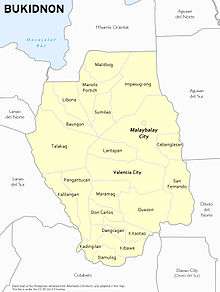
Bukidnon is a landlocked plateau in North Central Mindanao. It is bounded on the north by Misamis Oriental and Cagayan de Oro City; on the south by North Cotabato and Davao City; on the east by Agusan del Sur and Davao del Norte; and west by Lanao del Sur. It lies between parallels 7°25' and 8°38' north latitude and meridians 124°03' and 125°16' east longitude. Malaybalay City, the capital town, is about 850 kilometres (530 mi) by air from Manila and 91 kilometres (57 mi) by road from Cagayan de Oro City.
It has two important landmarks, Mount Kitanglad and Pulangi River. Mount Kitanglad has a peak of 2,899 metres (9,511 ft) above sea level. Pulangi River, on the other hand, traverses through the northeastern and southern part of the province towards the Rio Grande of Mindanao
Land area
The province's total land area is 10,498.59 square kilometres (4,053.53 sq mi),10,498.59 making it the largest in Mindanao in terms of land area. It accounts for 59 percent (59%) of Northern Mindanao. Thirty-eight percent (38%) is alienable and disposable. The rest is classified timberland.
It also accounts for 80 percent (80%) or 34 million metric tons of the region's nonmetallic mineral deposits which include high grade white and red clay, gold, chromite, copper, serpentine, manganese, quartz and limestone deposits can also be found in the province.
Topography
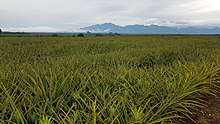
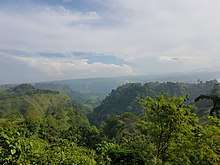

Bukidnon is generally characterised as an extensive plateau but the southern and eastern boundaries are mountainous area. The province's average elevation is 915 metres (3,002 ft) above sea level. The slope gradient peaks at 2,899 metres (9,511 ft) of Mount Kitanglad, an extinct volcano occupying the central portion. Two other mountain bodies are found in its southern portion, Mt. Kalatungan and Mt. Tangkulan, which rise to 2,287 metres (7,503 ft) and 1,678 metres (5,505 ft), respectively. Gently rolling grassland plateau cut deep and wide canyons of the Cagayan, Pulangi, and Tagoloan Rivers and their tributaries which cover a greater part of the province. The whole eastern and southern border adjoining the provinces of Agusan, Davao del Norte, and Cotabato are covered by lofty and densely forested mountains of the Pantaron Mountain Range (Central Cordillera). The Bukidnon plateau is mainly of volcanic zone consisting of pyroclastic, basaltic and andesitic cones.
The Central Cordillera is a mountain range of sedimentary, metamorphic and igneous rocks. About 49% of the land resource of the province is of rugged hills and mountains and 33% of undulating to rolling terrain. The rest of the province is composed of nearly level terraces, alluvial lowland, canyons and gorges. The volcanic terraces and volcanic foot slopes that are ≥500 m above sea level are estimated to be about 221,600 hectares (548,000 acres).
At Mailag, 23 kilometres (14 mi) south of Malaybalay City, the plateau begins to descend and gradually merges into the lowlands of Cotabato province.
Climate
Two types of climate prevail between the northern and southern sections of Bukidnon, The northern part is classified as belonging to Type III, that is, there is no pronounced rain period but relatively dry during the months of November to May. In the southern portion of the province, the climate is classified as Type IV with no dry season. The driest area is Baungon, while the wettest is the Calabugao plain. The climate is relatively cool and humid throughout the year.
The average annual rainfall is 2,800 millimetres (110 in). Just like in other parts of the country, rainfall is more pronounced from June to October compared to other months of the year. February to April are the drier months.
Temperature ranges vary with elevation. In areas lower than 500 metres (1,600 ft) above sea level (m.a.s.l.), the recorded temperature range is between 20 to 34 °C (68 to 93 °F). Areas with elevations greater than 500 metres (1,600 ft) above sea level would have temperatures ranging from 18 to 28 °C (64 to 82 °F).
Relative humidity also varies with elevation, with those above 500 m having relative humidity of about 80%, while areas lying below 500 metres (1,600 ft), 65-7 percent. Thus, the Malaybalay-Impasug-ong area and those around the volcanic cones approximate semi-temperate conditions and can support the cultivation of highland tropical crops.
Based on the records of climatological stations within and near the province, lithology and land form, three (3) agro-ecological zones are identified. One covers the mountainous eastern side (Central Cordillera) which is generally wet, with rainfall of about 2,340 to 4,000 millimetres (92 to 157 in) per annum. Another covers the high altitude volcanic plains, the Malaybalay-Impasug-ong area and the footslopes of Mt. Kitanglad and Mt. Kalatungan. These areas have an annual rainfall in the range of 2,490 to 3,680 millimetres (98 to 145 in). The third zone covers the south-central and the north-western parts of the province, with elevations of less than 500 meters, relatively dry with mean annual rainfall in the range of 1,700 to 2,600 millimetres (67 to 102 in).
Bodies of water
Bukidnon is known as the watershed of Mindanao. It is endowed with six major river systems namely: Pulangi, Tagoloan, Cagayan, Manupali, Muleta, and Bobonawan Rivers. These rivers carved the landscape of the province creating numerous canyons.
The Pulangi River, considered the longest river in the province, is a tributary of the Rio Grande of Mindanao. Its headwaters are found in the mountains of Kalabugao, Impasugong. It is the largest as well as the longest river found in the province. It covers the following cities and municipalities of the province: Impasugong, Malaybalay City, Cabanglasan, San Fernando, Valencia City, Maramag, Quezon, Don Carlos, Kitaotao, Dangcagan, Kibawe and Damulog.
The Tagoloan River has its headwaters in the mountains of Can-ayan, Malaybalay City. It traverses the province northwestward passing through Malaybalay City, Impasugong, Sumilao, Manolo Fortich, Malitbog and finally empties into the sea at Tagoloan, Misamis Oriental.
The Cagayan River watershed is found mostly in the municipality of Talakag. Its headwaters are found in the Kitanglad Mountain Range in central Bukidnon. The river flows northward through the municipalities of Talakag and Baungon. Its mouth lies at Cagayan de Oro City in Misamis Oriental, where it is the main source of potable water.
The Manupali River, a major tributary of the Pulangi River, start in the mountains of Lantapan, Bukidnon, picking up tributaries along the way from the Kalatungan and Kitanglad Mountain Ranges. It forms part of the natural boundary of the Valencia City and Lantapan. It flows eastward towards Malaybalay City, eventually joining the Pulangi River in Valencia City.
The Muleta River is found in the southern portion of the province covering the municipalities of Pangantucan, Don Carlos, Kitaotao, Dangcagan, Kibawe, Kadingilan and Damulog. It is another important tributary of the Pulangi River and flows southward. It will join the Pulangi River in the boundary of Bukidnon and Cotabato province.
The Bobonawan River, found in the municipality of Cabanglasan, is another tributary of the Pulangi River. It covers most of the parts of the municipality, flowing southward towards Pulangi River.
Aside from the relatively important river systems, various lakes also dot the landscape of the province. Pinamaloy Lake, in Don Carlos, Bukidnon, is the biggest in the province covering about 50 hectares. It was named after Barangay Pinamaloy, the place where the lake is located. Another lake is found in Pigtauranan, Pangantucan called the Napalit Lake. The lake covers an area of 36 hectares and is one of the tourist spots in Pangantucan, Bukidnon. There are 24 floating islets in the lake. The third significant inland body of water in the province is Apo Lake at Guinoyoran, Valencia City. It occupies an approximate area of 25 hectares. A man-made lake called Maramag Basin is found in Maramag, Bukidnon, which was the result of the construction of the Pulangi IV Hydroelectric Dam of the National Power Corporation (NPC) in the course of the Pulangi River.
There are numerous springs and waterfalls located in the province. Some of the waterfalls include the Alalum Falls, Dimadungawan Falls, Dila Falls, Gantungan Falls, Natigbasan Falls, Sagumata Falls, Magubo Falls, and Balisbisan Falls.
Transportation
There are several airstrips in the province being used by private firms. Commercial flights were used to be served by the Malaybalay Airstrip which was closed down by the provincial government in the late 1990s. The airport where it used to be located was converted into a low-cost housing project. A proposed domestic airport site in the municipality of Don Carlos has already been on the talks since 2008 and in 2013, the Bukidnon Airport Development Project proposal was finalized.[8][9][10] Budget allocation was done in 2017[11] and construction date is in 2018.[12] There are no seaports in the province because the place is landlocked. The province is accessible by road primarily from the cities of Cagayan de Oro and Davao with alternate road networks as well from the cities of Butuan, Iligan, Cotabato and the province of Lanao del Sur.
Politics and administration
Administrative divisions
Bukidnon is subdivided into 20 municipalities and 2 cities.
- † Provincial capital and component city
- ∗ Component city
- Municipality
| |||||||||||||||||||||||||||||||||||||||||||||||||||||||||||||||||||||||||||||||||||||||||||||||||||||||||||||||||||||||||||||||||||||||||||||||||||||||||||||||||||||||||||||||||||||||||||||||||||||||||||||||||||||||||||||||||||||||||||||||||||||||||||||||||||||||||||||||||||||||||||||||||||||||||||||||||||||||||||||||||||||||||||
Barangays
The province has 464 barangays under its jurisdiction. The table below shows the Top 20 Largest Barangays according to population.[4]
| Rank | Barangay | City/Municipality | Population (2015)[15] |
|---|---|---|---|
| 1 | Poblacion | Valencia City | 35,793 |
| 2 | Casisang | Malaybalay City | 25,696 |
| 3 | Lumbo | Valencia City | 16,082 |
| 4 | Poblacion | Quezon | 15,247 |
| 5 | North Poblacion | Maramag | 14,799 |
| 6 | Dologon | Maramag | 14,093 |
| 7 | Butong | Quezon | 13,258 |
| 8 | South Poblacion | Maramag | 12,165 |
| 9 | Damilag | Manolo Fortich | 11,713 |
| 10 | Batangan | Valencia City | 11,550 |
| 11 | Kisolon | Sumilao | 11,532 |
| 12 | Don Carlos Sur (Poblacion) | Don Carlos | 11,385 |
| 13 | Poblacion | Impasugong | 11,279 |
| 14 | Poblacion | Pangantucan | 10,970 |
| 15 | Bagontaas | Valencia City | 10,619 |
| 16 | Halapitan (Poblacion) | San Fernando | 10,221 |
| 17 | Agusan Canyon | Manolo Fortich | 11,385 |
| 18 | Sumpong | Malaybalay City | 9,302 |
| 19 | Alae | Manolo Fortich | 9,135 |
| 20 | Barangay 9 (Poblacion) | Malaybalay City | 9,033 |
Legislative districts
Bukidnon has four legislative districts namely the first, second, third and fourth districts.
| Legislative District | City/Municipality | Land Area | Population (2015)[4] | Density (2010) |
|---|---|---|---|---|
| 1st District | 2,229.17 km² | 302,272 | 125.14 person/km² | |
| 2nd District | 3,144.44 km² | 374,395 | 106.60 person/km² | |
| 3rd District | 1,816.11 km² | 450,839 | 228.08 person/km² | |
| 4th District | 1,104.06 km² | 287,720 | 244.71 person/km² |
Demographics
| Population census of Bukidnon | ||
|---|---|---|
| Year | Pop. | ±% p.a. |
| 1903 | 21,163 | — |
| 1939 | 57,561 | +2.82% |
| 1948 | 63,470 | +1.09% |
| 1960 | 194,368 | +9.77% |
| 1970 | 414,762 | +7.86% |
| 1980 | 631,634 | +4.30% |
| 1990 | 843,891 | +2.94% |
| 1995 | 940,403 | +2.05% |
| 2000 | 1,060,415 | +2.61% |
| 2007 | 1,190,284 | +1.61% |
| 2010 | 1,299,192 | +3.24% |
| 2015 | 1,415,226 | +1.64% |
| Source: Philippine Statistics Authority[4] [14] [14] [16] | ||
Based on the 2015 census, Bukidnon has a total population of 1,415,226 residents.[4]
In the 2000 census, males slightly edge the females with 546,234, accounting for about 52% of the province's total population while females, with 514,181, account about 48%. Based on age distribution, Bukidnon has a fairly young population, with ages 14 and below accounting 42.15% or 446, 952. The 15-34 age bracket account for 33.68% of the province's population or 357,112. Ages 55 and above barely accounts 6.5% of the total. The average population growth rate of the province is 2.05% (2.03% if exponential) from 2000-2010. Male-to-female ratio in the province stood at 1.06.
Population density
The average population density for the province is 128 persons per square km. The cities/municipalities with the highest population densities are the following: Don Carlos (353/km2), Kitaotao (250/km2), Valencia City (244/km2), Maramag (213/km2) and Quezon (202/km2). The cities/municipalities with the lowest densities, on the other hand are: Impasugong (29/km2), Talakag (58/km2), San Fernando (63/km2), Malitbog (75/km2) and Damulog (83/km2).
Population by congressional districts
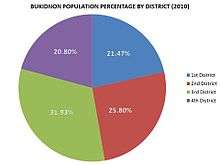
By Congressional Districts, District III has the highest population among the four capturing 31.86% of the total population of the province. It is followed by District II with 26.45% of the total population. Third is District I has a population percentage of 21.36%. The least populated district is District IV with population percentage of 20.33%.
Valencia City has the highest population among the cities/municipalities of the province with 192,993 inhabitants, accounting 13.64% of the province's total. It is closely followed by Malaybalay City with 174,625 inhabitants or 12.34% of the total. Quezon is at third with 104,116 inhabitants or 7.36% of the total. Maramag and Manolo Fortich are 4th and 5th with 102,089 and 100,210 inhabitants, respectively.
The four largest local government units of Bukidnon (Valencia, Malaybalay, Quezon, and Maramag) are clustered together in the central part of the province. It is also in the national roads of these cities/municipalities that daily road use volume are high.
Ethnicity
According to ethnicity, majority of the people in Bukidnon are Cebuano accounting approximately 41% of the total population. The Bukidnon lumads (Bukidnon, Higaonon, Manobo, Talaandig, etc.) account about 24% of the total population of the province. The Maranaos are about 8% of the total population. The Hiligaynon/Ilonggo and Boholano groups follow with 12.7% and 7.37%, respectively, of the province's total population.
Indigenous inhabitants of Bukidnon are the Lumad peoples, including the Bukidnon, Higaonon, Manobo, and Talaandig. Their cultures and traditions are embodied in oral folk literature of the province which are classified into; Antoka (riddles), Basahan (proverbs or wise sayings), Kaliga (ceremonial songs), Limbay (lyric poem), Sala (love song), Idangdang (ballad), Ulaging (epic) and Nanangon (folktales). Religion is monotheistic. They believe in one God. Magbabaya (the ruler of all) has minor gods and goddesses under his command (Example: Bulalakaw watches rivers and lakes, Tumpas Nanapiyaw or Itumbangol watches the bases of the earth, night, and day).
Many of the population, however, are recent Christian immigrants from Cebu or elsewhere in the Philippine archipelago.
Religion
Majority are Christians (predominantly Roman Catholic, 80.7% with significant other Christian denomination minority, 15%). Islam has 4% while the percentage who listed as others are at 0.3%.
Languages
The lingua franca of the region is Cebuano. Also spoken, although at low percentage, are Higaonon, Binukid, Hiligaynon/Ilonggo, Tagalog, Maranao, Ilocano, and Waray-Waray. English is generally understood and is widely used in schools, business and government offices.
Economy
_1.jpg)
Bukidnon is an agricultural economy. It is a major producer of rice, maize, sugar, coffee, rubber, pineapple, banana, tomato, flowers, cassava, and other fruits and vegetables. Almost all large firms operating in the province are into production or processing of these agricultural products. Recognized by the Food and Agriculture Organization as a foot-and-mouth disease-free province, it is also a major producer of poultry, hogs, goats and cattle. Dairy products out of water buffalos are being produced at the Philippine Carabao Center's outlet in Central Mindanao University. Due to being landlocked, Bukidnon relies on the nearby cities of Cagayan de Oro, Iligan and Davao for the supply of marine products, however the province has its own supply of freshwater products such as tilapia, carp, catfish, mudfish, gourami, goby, freshwater eels, giant freshwater prawn, cultured native freshwater snails and freshwater crabs, either via inland fishing or fry production aquaculture in inland fish farms and fish hatcheries.
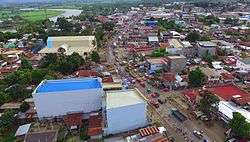
Del Monte Philippines, Inc. (DMPI), Lapanday Diversified Products Corp. and Mt. Kitanglad Agri-Development Corporation are engaged in pineapple production. Dole Philippines (Skyland) and Mt. Kitanglad Agri-Ventures, Inc. are into banana production. DMPI is also engaged in cattle fattening. Bukidnon Sugar Milling Corporation (BUSCO) and Crystal Sugar Milling are into sugar milling and refining.
Phil-Agro Industrial Corporation is in starch production. Menzi Agricultural Development is in cacao production. Agaropyta Phils. Inc., Bukidnon Greens Inc., FP Obrero Farms and ARDEM, Inc. are in cutflower production.
Food manufacturing giants, San Miguel Foods Corp. (SMPFCI), Monterey Farms Corp., Swift Foods, Inc. have intensified their contract breeding and growing operations in the province. Valencia Rubbertex, Inc., an 80-20 Japanese-Filipino joint venture produces rubber boots and rubber shoes for Japan.
As one of the major anchors in crop production, Bukidnon is moving forward towards establishing its position as a principal trader of rice, corn, sugar, potato, tomato and many other commercial and industrial crops. As the second largest producer of corn in the country, it reached a total production of 481,370 Mt. In year 2000, vast tracts of cornfields, rice paddles and sugar plantations are distributed all over the province.
Bukidnon has already assumed its role as producer and supplier of fresh fruits and vegetables. These produce are either sold in domestic markets or exported to Japan and other neighboring countries. Fresh pineapples, banana, sugarcane and cutflower grown over the years are among its exports. New agri-business industries are still growing such as strawberry farming. Even export of rubber boots and shoes, an infant industry in the province is increasing tremendously.
A wide variety of resource-based handicrafts is extensively produced from rattan, bamboo and wood. San Fernando is known for its rattan furniture. Bamboo baskets, wood wares and carvings, mats and other handmade products are ideal souvenir items.
Bukidnon Investment Grid
During the mid-90's, the provincial government of Bukidnon, after careful studies and consultation, has adopted a strategic program called the Bukidnon Investment Grid or BIG. This program is aimed to confine all its investment promotion activities and projects to the strip of land three kilometers from both sides of the Sayre Highway from Damulog to Manolo Fortich, and along the national/provincial road from Kibawe to Kadingilan; Don Carlos to Kadingilan; Maramag to Quezon; Maramag to Kadingilan; Kadingilan to Pangantucan; Valencia City to San Fernando; Malaybalay City to Cabanglasan; Malaybalay to Lantapan; Manolo Fortich to Libona; Libona to Cagayan de Oro; Talakag to Pangantucan; and Malitbog to Tagoloan in Misamis Oriental.
Education
Universities and colleges
The following universities and colleges of Bukidnon are the tertiary schools.
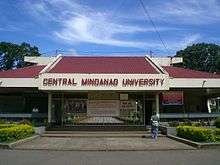
| School | Location |
|---|---|
| AMA Computer Learning Center | Hagkol, Valencia City |
| Bukidnon State University | Malaybalay City |
| Central Mindanao University | Musuan, Maramag, Bukidnon |
| Don Carlos Polytechnic College | Poblacion, Don Carlos, Bukidnon |
| IBA College of Mindanao | Valencia, Bukidnon |
| Maramag Polytechnic College | North Poblacion, Maramag, Bukidnon |
| Mindanao Arts and Technological Institute | Malaybalay City |
| Mountain View College | MVC Complex, Mt. Nebo, Valencia City |
| Northern Bukidnon Community College | Manolo Fortich, Bukidnon |
| Philippine College Foundation | Valencia, Bukidnon |
| Philippine Countryville College | Maramag, Bukidnon |
| Quezon Institute of Technology | Quezon, Bukidnon |
| San Agustin Institute of Technology | Valencia City |
| San Isidro College | Impalambong, Malaybalay City |
| STI Learning Center | Malaybalay City and Valencia City |
| St. James School of Science and Technology | Malaybalay City |
| Valencia Colleges (Bukidnon), Inc. | Valencia City |
Festivals
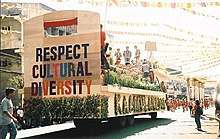
The province celebrates the Kaamulan Festival, an ethnic cultural festival held annually in Malaybalay City, Bukidnon from the mid-February up to March 10, the founding date of the Bukidnon as a province in 1917. It is held to celebrate the culture and tradition of the seven ethnic tribal groups—Bukidnon, Higaonon, Talaandig, Manobo, Matigsalug, Tigwahanon and Umayamnon—that originally inhabit the province. Kaamulan comes from the indigenous Binukid word amul meaning "to gather". Kaamulan is gathering for a purpose—a datuship ritual, a wedding ceremony, a thanksgiving festival during harvest time, a peace pact, or all of these together. The festival started in 1974 and is celebrated until now. It is the only authentic ethnic festival in the Philippines.[19]
Bukidnon Hymn: Bukidnon My Home
The Provincial Hymn was composed by Filomeno Bautista between 1925 and 1932. Nimecio Jun Beltran authored a provincial resolution requiring the singing of the provincial hymn in all and every events in the Province of Bukidnon where the Philippine National Anthem is also sung.
| Official Binukid Version: Bukidnon Kanak Ha Banuwa |
Official English- version: Bukidnon My Home |
Unofficial Cebuano Version: Bukidnon Matahum |
|---|---|---|
|
Bisán pa hindu a |
Wherever I may roam |
Bisan asa kita |
Notable people
- Gerald Tabios - elite endurance athlete
- Alfredo Lagamon - Associate Justice, Court of Appeals
- Caesar Fortich - Secretary of Agriculture
- Clare Cabiguin - Pinoy Big Brother: Teen Edition 1 - 4th Placer
- Elenito Galido - Bishop of the Roman Catholic Diocese of Iligan
- Joey Ayala - Singer-songwriter and composer
- Juan Miguel Zubiri - Politician
- Lorenzo S. Dinlayan - USEC, Office of Cultural Communities
- Oona Barretto - Scholar of Pinoy Dream Academy (season 1)
- Nelbert Omolon - PBA Player
- Nereus Acosta - Politician
- Reynan Dal-Anay - 1st Runner-up of The Voice Kids (Philippines season 2)
- Roel Manlangit - Grand Champion of Pilipinas Got Talent (season 4)
- Romeo M. Recina - Brig. Gen., PC-INP Recom 11 Commander
- Sheree (real name Sweet Faye Agustin) - Singer / dancer / model & actress (former Viva Hot Babe)
- Virgilio Garcillano - Former government official
- Ivy Grace Paredes – The X Factor UK 2016 contender
- Rowell "Roy" Ucat – internet celebrity, songwriter, popularly known as "Medyo Maldito"
- Mario Fernandez – a multi-medalist national boxer
- Teofisto Guingona III – politician/former senator
See also
References
- ↑ "Department of Tourism". tourism.gov.ph. Archived from the original on 21 March 2018. Retrieved 1 May 2018.
- ↑ "Bukidnon Celebrates 100th Year in 2014". Provincial Government of Bukidnon. 2014-03-19. Archived from the original on 2015-09-28. Retrieved 2015-09-27.
- 1 2 "List of Provinces". PSGC Interactive. Makati City, Philippines: National Statistical Coordination Board. Archived from the original on 21 January 2013. Retrieved 10 June 2014.
- 1 2 3 4 5 6 7 Census of Population (2015). "Region X (Northern Mindanao)". Total Population by Province, City, Municipality and Barangay. PSA. Retrieved 20 June 2016.
- ↑ Sombrito, Elvira. "Soil Redistribution Studies Using Fallout 137Cs" (PDF). International Atomic Energy Agency. Retrieved 9 September 2010.
- ↑ "Mt. Dulang-Dulang (2,938+)". ~ Pinoy Mountaineer. 2007-09-02. Archived from the original on 2012-08-30. Retrieved 2012-10-27.
- ↑ "The highest mountains in the Philippines ~ Pinoy Mountaineer". Pinoymountaineer.com. 2008-02-02. Archived from the original on 2012-10-25. Retrieved 2012-10-27.
- ↑ "Bukidnon Airport (Maraymaray Airstrip) in Don Carlos, Bukidnon by Philippine Aviation". PBase. Archived from the original on 23 October 2017. Retrieved 1 May 2018.
- ↑ Bukidnon airport to be constructed in 2012 – Sen. Zubiri (Bukidnon News) Archived 2015-12-22 at the Wayback Machine.
- ↑ Don Carlos is best choice for Bukidnon airport (MindaNews)
- ↑ Maraymaray, Don Carlos; Bukidnon Airport Development Project (Don Carlos Official Website) Archived 2017-08-08 at the Wayback Machine.
- ↑ Admin, CDODev (7 January 2018). "PROJECT WATCH: New Bukidnon (Don Carlos) Development Airport to start this year; P425 million budget allocated". cdodev.com. Archived from the original on 8 January 2018. Retrieved 1 May 2018.
- ↑ "Province: Bukidnon". PSGC Interactive. Quezon City, Philippines: Philippine Statistics Authority. Retrieved 8 January 2016.
- 1 2 3 Census of Population and Housing (2010). "Region X (Northern Mindanao)". Total Population by Province, City, Municipality and Barangay. NSO. Retrieved 29 June 2016.
- ↑ Census of Population (2015). Highlights of the Philippine Population 2015 Census of Population. PSA. Retrieved 20 June 2016.
- ↑ Cairns, Malcolm (2015). Shifting Cultivation and Environmental Change: Indigenous People, Agriculture and Forest Conservation. Routledge. ISBN 9781317750192. Retrieved 29 June 2016.
- ↑ "Archived copy". Archived from the original on 2018-03-04. Retrieved 2018-03-04.
- ↑ "Table 11. Household Population by Ethnicity and Sex: 2010" (PDF). psa.gov.ph. Archived (PDF) from the original on 30 March 2018. Retrieved 1 May 2018.
- ↑ "Foreign diplomats to grace Bukidnon's Kaamulan fest".
External links


- Provincial Government of Bukidnon
- Philippine Standard Geographic Code listing for Bukidnon
